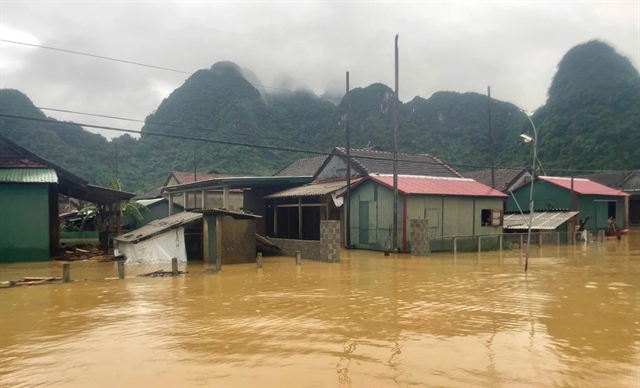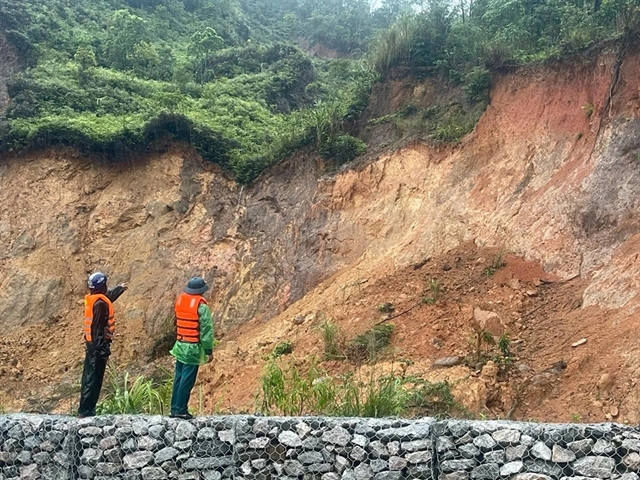 Environment
Environment

 |
| Houses in Tân Hóa Commune (Minh Hóa District, Quảng Bình) were submerged in water from 0.5 to 2 metres. Photo thanhnien.vn |
QUẢNG TRỊ - Tropical Storm Soulik, or Typhoon No.4 has caused widespread flooding and landslides across several provinces in central Việt Nam, leading to isolation in many areas.
Households have been submerged, with some locations requiring continued evacuation due to landslides along key roads.
As of late yesterday, rain had eased off in Hà Tĩnh, Quảng Bình, and Quảng Trị. In Hà Tĩnh, some rural roads in the districts of Hương Khê and Vũ Quang remained flooded. In Quảng Bình, 1,150 households were still underwater, and 38 villages remained isolated.
Soulik has injured one person (in Thừa Thiên-Huế) and damaged 96 houses (63 in Hà Tĩnh, four in Quảng Trị, 12 in Thừa Thiên-Huế, and 17 in Quảng Nam). In terms of transportation, 16 roads and low-lying crossings were flooded, and more than 100 landslides occurred (86 in Quảng Bình, eight in Quảng Trị, one in Thừa Thiên-Huế, and seven in Quảng Nam).
On September 20, the Quảng Trị Province's Steering Committee for Natural Disaster Prevention and Search and Rescue reported that over 1,000 households had to be evacuated due to the storm’s impact. Heavy rain triggered landslides, depositing more than 50 cubic metres of soil and rock onto National Highway 14 in Hướng Lập Commune (Hướng Hóa District), cutting off traffic. By the afternoon, roads leading to Húc, Hướng Tân, and Hướng Linh communes (Hướng Hóa District) were only just reopened after being cleared of landslide debris. Many areas in Vĩnh Linh District were left without power due to damage to the electricity grid, with recovery efforts still ongoing.
In Quảng Bình, heavy rainfall has continued, with river water levels expected to rise further. Local authorities have deployed teams to monitor the situation, set up warning signs, and prepare to assist residents once the floodwaters recede. Previous rains caused the upper reaches of the Gianh River to swell, inundating several residential areas. Rising river levels in the mountainous districts of Minh Hóa, Tuyên Hóa, Bố Trạch, and Quảng Ninh have also been reported. As of the afternoon of September 20, 37 villages with more than 600 households in Quảng Bình were flooded, with Minh Hóa District being the most affected, as 538 households experienced flooding ranging from 0.5-2 metres deep. All affected households had been evacuated.
Currently, 44 road sections in Quảng Bình have been cut off due to landslides, with Tuyên Hóa District being the worst hit. Several dams and bridges in the communes of Mai Hóa, Văn Hóa, Thanh Thạch, Lâm Hóa, and Kim Hóa (Tuyên Hóa District) are experiencing water levels rising between 1 and 1.5 metres, making transportation impassable.
On the same day, two ships in Quảng Bình encountered trouble while anchored to avoid the storm. At 10am, the fishing vessel QB-98043 TS broke its anchor and was capsized by the waves. Earlier, the cargo ship Nam Anh 69, while anchored at the Gianh River mouth, got entangled in oyster farming cages, causing it to drift two nautical miles offshore. Salvage operations were set to begin early this morning (September 21) when the tide rises.
 |
| A landslide caused road disruptions along National Highway 14 through Hướng Lập Commune (Hướng Hóa District, Quảng Trị). Photo thanhnien.vn |
Dangerous mountain crack discovered
In Quảng Nam, on the morning of September 20, Nguyễn Đăng Chương, Vice Chairman of the Nam Giang District People's Committee, personally inspected a large crack running along a mountainside behind Hamlet 56B, Đắk Pre Commune. District leaders reported they would hold discussions on emergency measures and report to the Quảng Nam Provincial People’s Committee for urgent solutions for affected households, including the possibility of establishing a new resettlement area. The crack, discovered on the afternoon of September 19 after more than two days of heavy rain, extends approximately 130 metres, with a depth of 1.5 to 5 metres and a width of 50 centimetres to 4 metres in some sections. There are signs of water seepage and landslides, posing a risk to houses below. Local authorities urgently evacuated 11 households with 41 residents living at the foot of the mountain to temporary shelters.
In Nam Trà My District, heavy rain caused dozens of houses to suffer cracked foundations, with rocks and soil flooding homes and creating numerous landslides. Trần Duy Dũng, Chairman of the Nam Trà My District People’s Committee, reported that 51 households with 164 people had been evacuated. Additionally, over 30 tonnes of rice had been stockpiled in warehouses and schools in preparation for potential food shortages due to landslides cutting off access to the area.
In Đông Giang District, 12 households were also urgently evacuated from landslide-prone areas, and food and essential supplies were distributed to ensure enough provisions for 10 days.
Flood warnings in Hà Tĩnh
On the morning of September 20, in Hà Tĩnh, prolonged heavy rain flooded many roads and bridges in the districts of Cẩm Xuyên, Vũ Quang, Hương Sơn, and Hương Khê, isolating several communities. Local authorities have placed warning signs and banned people and vehicles from entering flooded areas. Rising water levels have also increased the inflows to local reservoirs.
According to Hà Tĩnh’s Steering Committee for Natural Disaster Prevention and Search and Rescue, from 5 p.m. on September 19, the Hố Hô Hydropower Plant (Hương Khê District, Hà Tĩnh) began releasing water at a rate of 78 cubic metres per second, which increased to nearly 600 cubic metres per second by late that night. By the afternoon of September 20, the discharge was reduced to 443 cubic metres per second. That same afternoon, the Hương Sơn Hydropower Plant (Hương Sơn District, Hà Tĩnh) discharged water at a rate of 15.4 to 92 cubic metres per second. Earlier in the day, the South Hà Tĩnh Irrigation Company also released water from the Kim Sơn and Thượng Sông Trí reservoirs (Kỳ Anh Town, Hà Tĩnh) at a rate of 5 to 100 cubic metres per second.
With heavy rain forecast to continue, Hà Tĩnh authorities have relocated 49 households from low-lying and landslide-prone areas to safe shelters. According to the Hà Tĩnh Department of Education and Training, nearly 28,000 students across 34 schools, ranging from preschools to high schools, were unable to attend classes on September 20 due to deeply flooded roads and isolated villages. VNS




